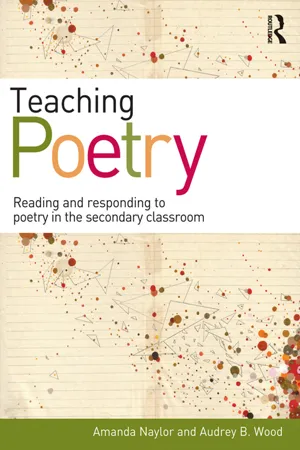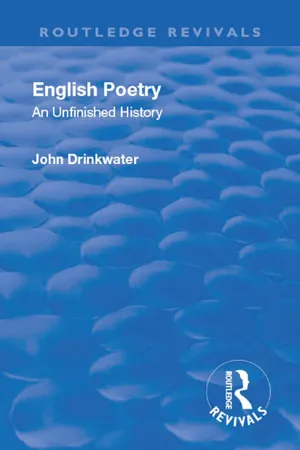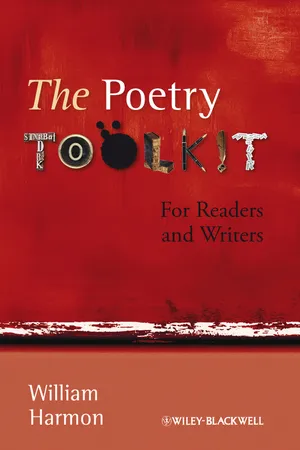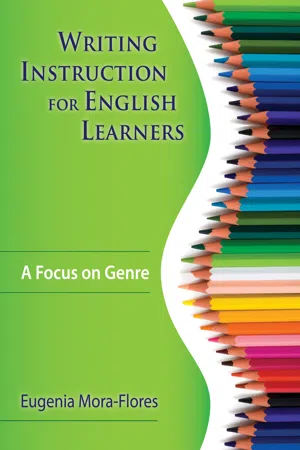Narrative Poetry
Narrative poetry is a form of poetry that tells a story through verse. It often includes characters, a plot, and a setting, and can range from epic poems to ballads. Narrative poems use poetic devices and language to create a vivid and engaging storytelling experience for the reader.
7 Key excerpts on "Narrative Poetry"
- eBook - ePub
Teaching Poetry
Reading and responding to poetry in the secondary classroom
- Amanda Naylor, Audrey Wood(Authors)
- 2012(Publication Date)
- Routledge(Publisher)
...The Romantics were interested in Narrative Poetry, with Wordsworth, Byron, Coleridge and Keats all turning their hands to the form. Yet today the form has fallen out of favour. What does the narrative poem offer contemporary students and how can we teach it? What are we looking for when we do teach it? One place to start is a consideration of which genre Narrative Poetry draws on. Culler observes: Historically, many theorists of genre have followed the Greeks, who divided works among three broad classes according to who speaks: poetic or lyric, where the narrator speaks in the first person, epic or narrative, where the narrator speaks in his own voice but allows characters to speak in theirs, and drama, where the characters do all the talking. (Culler 1997: 74) Narrative Poetry operates somewhere in the midpoint between the genres of lyric and narrative. The form is definitely poetic, and lyrical in the use of stanza, rhythm and metaphor, whereas there are also characters present who ‘speak’ in their own voices. Whether we agree with Culler’s definition above or not, what it does suggest is that in studying Narrative Poetry, we need to apply the principles of studying narrative, which at its most pared-down is character, plot and chronology and also those of studying poetry, such as language choice, metaphor and repetition. That Narrative Poetry has a rich history cannot be denied. But what does it offer today’s pupils? There is no doubt that as teachers we are inheritors of the legacy of the National Literacy Strategy (NLS), where the emphasis upon pace and focus ‘tacitly encourages the promotion of a “snippet culture” in terms of engagement with literary texts’ (Stevens and McGuinn 2004: 66)...
- eBook - ePub
Revival: English Poetry: An unfinished history (1938)
An unfinished history
- John Drinkwater(Author)
- 2018(Publication Date)
- Routledge(Publisher)
...VI POETRY AND NARRATIVE (1) T HE popularity of any specific literary work is notoriously an uncertain criterion of merit, but the permanence of a literary form in popular favour cannot but indicate a basic fitness. Of all literary forms, or figures, the story has, first and last, most taken the fancy of men. Criticism has sometimes sought, unsuccessfully I think, to identify the ejaculations of primal life in its ooze with the first expressions of lyric poetry. Within more measurable horizons of experience, the lyric appears to have waited on a later development of society than narrative. In any case, we may say with certainty that effective appeal from the poet to an audience has always been made earlier and more easily by a tale about something than by a recital of his own emotions about something. This is not to place narrative either below or above lyric in art. There is no aesthetic theory by which lyric could be shown to be less necessary to the full consummation of poetic achievement as a whole than narrative, but there is ample reason for concluding that in the long progress of literature it is the story that has been the form most generally desired. That narrative has commonly, and particularly in later times, forsaken verse for prose makes no matter. It is therefore not surprising to find that the first work in English poetry, or English literature, to reach undoubted greatness and also to establish a lasting hold on popular favour, was a narrative poem, or rather a series of narrative poems so conceived and arranged as to make an organic whole. To say that England before The Canterbury Tales had no poetry would be a patent exaggeration, but it had none that was not written in what for us to-day is virtually a foreign tongue, and none that for the past three hundred years has had any claim to popular significance, or any appreciable influence on the practice of the poets. Chaucer changed all that at a stroke...
- eBook - ePub
The Poetry Toolkit
For Readers and Writers
- William Harmon(Author)
- 2012(Publication Date)
- Wiley-Blackwell(Publisher)
...Chapter 1 The Arts of Story-Telling Most poems belong in one of three categories: NARRATIVE, DRAMATIC, LYRIC. Narrative poems, like many prose narratives, give an account of an action or incident. Insofar as they tell stories, poems and prose texts do not much differ. Since everybody enjoys hearing stories and almost everybody tells stories sooner or later, there is not much mystery about the arts of story-telling. There is, however, a good deal of controversy about the technical terminology of story-telling, and a number of vexatious words have emerged since 1970. “Narratology,” which first appeared in English in 1971, has caused some complaints because, among other offenses, it mixes Latin and Greek elements. But the same complaints were once prompted by “television,” “homosexual,” and even “bicycle” (some wanted “dicycle”!), but those words have long since joined the mainstream. Even so, narratology has remained an awkwardly technical-seeming term without very much technical material to justify it. Likewise, “prosaics” has been suggested as a complement to “poetics,” on a rather shallow analogy: if poetry has poetics, prose ought to have “prosaics.” And one can see titles like “The Prosaics of Ancient Romances.” But prosaic has a well-established primary meaning of “mundane,” “routine,” “commonplace,” “dull,” and it seems unlikely that “prosaics” will ever gain much ground as a critical term for anything but mild condemnation. Turbulence in terminology may suggest chaos or confusion, but it may just as well suggest a productive ferment. It is worth mentioning here that, as one progresses through the six main elements of a literary work – PLOT, CHARACTER, MENTAL STATE, DICTION, SOUND EFFECTS, GRAPHIC EFFECTS – one goes from almost unlimited regions of ill-defined concepts that merge helter-skelter into one another. Then, with diction, one reaches matters somewhat more definite, or at least less indefinite...
- eBook - ePub
Philosophy of the Arts
An Introduction to Aesthetics
- Gordon Graham(Author)
- 2005(Publication Date)
- Routledge(Publisher)
...We can be led in many different and competing directions by arguments and experiments which all claim validity, and so too we may expect poetic revelation to throw up a variety of images for our consideration. But enough has been said to establish the claim that poetic form is not just an agreeably ornamental way of saying things whose truth or substance is to be established in some other way. The relation between what is said in poetry and how it is said can be more intimate than that. However, even if it is accepted that poetry as a form of understanding does not yield to paraphrase without significant loss there is a further question for this chapter to address: can the same be said of the other literary arts? The poetic forms described and discussed so far are closely connected with ‘poetry’ narrowly understood. Other literary arts have other forms, and it needs to be shown that these are also ways of directing the mind to a better apprehension of some aspect of human experience. Can storytelling, whose form is narrative, be used in this way? Narrative and fiction The device of multilayered representation is to be found in novels as well as in poetry. A striking counterpart in this respect to Browning's My Last Duchess is Kazuo Ishiguro's novel The Remains of the Day, subsequently made into a highly successful film. Ishiguro's story is set in the England of the 1950s. The principal character is a butler, Stevens, who takes a few days' holiday motoring across the countryside with the ultimate purpose of seeking out a former colleague. The journey provides the occasion and the context for extended reminiscences of previous, rather more glorious periods of service. The story is told in the first person from the butler's point of view and, to a degree, Stevens reminisces in order to construct an apologia, a self-justification of his past actions and attitudes...
- eBook - ePub
Why Reading Books Still Matters
The Power of Literature in Digital Times
- Martha C. Pennington, Robert P. Waxler(Authors)
- 2017(Publication Date)
- Routledge(Publisher)
...The poet creates the meaning and effect of a poem through words and expressions carefully selected to have certain connotations and associations and carefully arranged in patterns which stand out and which, if read deeply, allow multiple layers of interpretation, leading to a sort of epiphany. In the words of David Morley in The Cambridge Introduction to Creative Writing, “Poetry is a form of creating … epiphanies through making lines of language, the internal arrangement of which … carries the poem into memory” (Morley, 2007, p. 196) and, we would add, into deep feeling and interpretive consciousness. Poetry, like other forms of literature and art, is characterized by its originality and imaginative use of its medium of expression to create unusual verbal effects through defamiliarization and what the Czech linguist and literary theorist Jan Mukařovskỳ described as “foregrounding” of expression to “[achieve] maximum intensity” (Mukařovskỳ, 1964/1932, p. 44). As linguists and literary scholars have noted, poetry is characterized by novel or deviant language, such as original words, word combinations, and uses of words, and original structure – the linguistic grammar and rhetoric as well as the visual grammar or structure and rhetoric. Vendler (2015) characterizes “the import of poetry” as “the power of idiosyncratic style,” which she goes on to classify as “linguistic and structural idiosyncrasy” (p. 2). Bloom, like Vendler a respected critic and scholar of poetry, describes it thus in The Art of Reading Poetry : “Poetry essentially is figurative language, concentrated so that its form is both expressive and evocative. Figuration is a turning from the literal, and the form of a great poem itself can be a trope (‘turning’) or figure” (Bloom, 2004, p. 1). Figuration comprises literary means to produce effects of defamiliarization and foregrounding. Bloom (p...
- eBook - ePub
Writing Instruction for English Learners
A Focus on Genre
- Eugenia R. Mora-Flores(Author)
- 2008(Publication Date)
- Corwin(Publisher)
...Narratives are the stories children love to hear, read, and enjoy. Though many narratives are accounts or recounts of things we have done or stories we have heard, our experiences also give us ideas for original stories. The following list details the main aspects of narrative writing: • Can be fiction or nonfiction, based on personal experiences, inspired by personal experiences, or completely made up; • Includes literary elements of plot, setting, and characters that are well defined and developed; • Answers who, what, when, where, how, and why about something we have experienced or have created; • Uses colorful details to help the reader share in the experience with you; • Presents information logically (from beginning to end) while at the same time can be craftly written with flashbacks or cyclical plotlines; • Contains dialogue (when appropriate) to provide insight into the thoughts and actions of the characters; • Provides a point or theme to the story; and • Can be written from any point of view. A misconception about English learners (ELs) is that they cannot write until they have mastered at least a conversational level of the English language. However, as we noted in the opening chapter, all students have ideas for stories through their lived experiences. These experiences are not language specific; all students have gathered a vast amount of ideas from their lives to write about. What we need to do as teachers is to help them find the medium by which to share their stories in English. This includes allowing ELs opportunities to express themselves in creative ways (see Figure 1.5, Written Output Development for English Learners). They can begin by drawing or sketching their ideas. Eventually they will gradually transfer what they are learning in English, orally and in writing, to write words and stories. English learners need to feel safe playing with language to share their ideas in English...
- eBook - ePub
Creativity and Writing
Developing Voice and Verve in the Classroom
- Teresa Grainger, Kathy Goouch, Andrew Lambirth(Authors)
- 2005(Publication Date)
- Routledge(Publisher)
...Chapter 8 Artistic voices Poetry Poetry is a multimodal form of communication. This has been recognised by poets across the ages and by those readers who have become devotees. Children who play with language, its sense and savour, rhythms and rhymes also implicitly understand this. The intrinsic pulse of poetry incites physical movement from the lips to the limbs and demands that poetry is read with voice and verve. Its multimodality means that poetry does not live easily on the page, and needs to be ignited by all available means to allow readers to engage with its complexity and release its potential. Readers deserve to see, hear, taste and feel the patterns of poetry, and writers too may use all their senses in composing and animating meaning. Research and inspection evidence has shown that children, as they grow older, often demonstrate an antipathy towards poetry at school (O’Brian, 1985; Dias and Heyhoe 1988; OfSTED, 1993; QCA, 1998). This may be because schools tend to operate in a mono-semiotic system, basing much, if not all their poetic practice, in the logic of the written word. Children meeting poetry in such an environment are unlikely to perceive it as having life outside this single mode of communication, and will construct their own theories of poetry based upon such limited practice (Fleming, 1992). Outside the classroom however, children engage in a rich world of language play, through playground rhymes, songs, chants, jingles, jokes and lyrics although they may not recognise these as poetic experiences (Grainger, 1997)...






